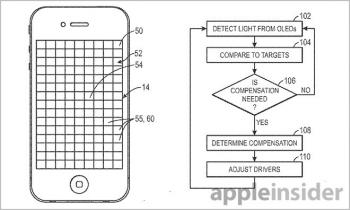Apple new patent describes placing photo-diodes between OLED pixels for ambient light and lifetime compensation
The US PTO published a new patent from Apple (filed in 2012) that describes how to use sensors to compensate for ambient lighting (see DisplayMate's related recent article) and lifetime brightness degradation in OLED displays. The patent describes that photo-diodes can be placed inside the OLED array or above and below it.

Putting photo-diodes inside the display will enable them to more accurately measure light levels. So if a part of the screen is dimmer than the rest of the screen (for example because only a part of the display is under direct light) - the photodiode will detect it and then the display brightness in that area can be increased. This is something that cannot be achieved with a single sensor. Those photodiodes can also be used to learn whether certain OLED pixels (or pixel groups) have lowered brightness due to aging. Then the display can compensate and drive these pixels higher.





